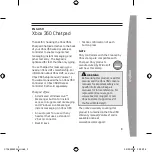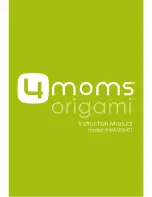
Inside the MIDI Drawbar carton you will find the following:
1.
MIDI Drawbar unit
2.
12 volt AC adapter
3.
user's manual
4.
Velcro strips
5.
Envelope containing 4 control knobs
6.
warranty card
Please return the warranty card soon after your purchase. This card will allow Voce to keep you informed of updates
and new products.
Velcro is a registered trade mark of Velcro USA Inc.
Rear Panel
The MIDI Drawbar rear-panel contains mostly connectors. Refer to the diagram on page 2. The labels for the rear-
panel connectors and switches are on the top face plate. You'll find the following on the rear-panel:
1.
POWER SWITCH - push on / push off switch
2.
POWER JACK - The 12-volt AC wall adapter connects to the MIDI Drawbar via this connector.
3.
MIDI OUT - 5-pin DIN MIDI output. This MIDI output is used to send merged data from the MERGE IN
input and front-panel controls to an external MIDI device such as the V3.
4.
MIDI MERGE in - 5-pin DIN MIDI input. This MIDI input is used to merge MIDI data from a keyboard or
computer with MIDI data created by the MIDI Drawbar.
5.
EXPRESSION PEDAL input - A potentiometer or control voltage foot pedal can be connected to this input
to send MIDI control #8. This 1/4" stereo jack conforms to the following specification: Tip=control voltage
input, Ring=510 ohm resistor connected to 5 volts, Sleeve=ground. For a control voltage foot pedal use
positive 0 to 5 volts connected to the Tip and the Sleeve is grounded.
6.
FT SW - tip/ring/sleeve type 1/4" connector for attaching momentary foot-switches for toggling the
Slow/Fast and Brake functions. Tip and sleeve is the connection for the Slow/Fast function while ring and
sleeve is the connection for the Brake function.
7.
MIDI CH - 16-position rotary switch. Selects basic MIDI channel.
8.
MAIN/AUX switch - selects whether the drawbars send to the main V3 drawbar control numbers or the
AUX morph drawbar control numbers. (AUX is mainly used for a second set of drawbars on a manual).
Front Panel
There are three types of controls provided for the user on the MIDI Drawbar. Refer to the diagram on page 2.
Section 1 contains nine push-button type controls with associated indicators, section 2 contains four rotary controls
(knobs), and section 3 contains nine drawbars.
When used with the V3, these three types of controls provide the user with instant access to many of the V3's
controls and parameters. The MIDI Drawbar can send fourteen different continuous-controller messages as well as


























